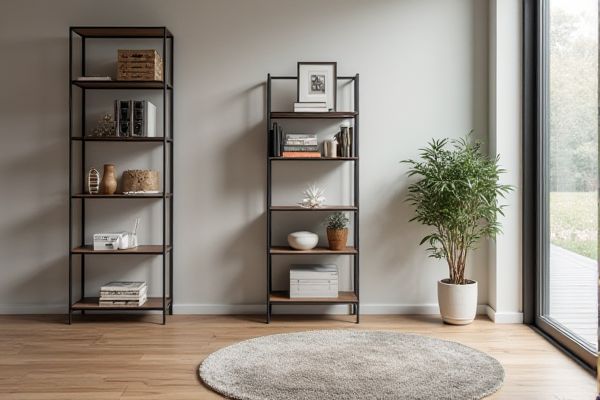
Wall-mounted racks save floor space and provide a streamlined look, making them ideal for smaller rooms or tight spaces. Free-standing racks offer greater flexibility and portability, allowing you to reorganize or move them as needed; explore the rest of the article to find out which option suits your needs best.
Table of Comparison
| Feature | Wall-Mounted Racks | Freestanding Racks |
|---|---|---|
| Installation | Requires secure wall attachment | No installation needed, self-supporting |
| Space Efficiency | Saves floor space, ideal for small rooms | Requires dedicated floor area |
| Weight Capacity | Limited by wall strength and anchors | Higher capacity, distributes weight on floor |
| Portability | Fixed, not portable | Movable, can be relocated easily |
| Installation Cost | Potentially higher due to wall mounting | Generally lower, no mounting required |
| Use Case | Best for lightweight storage, limited space | Best for heavy equipment, flexible layout |
| Durability | Dependent on wall condition | Robust, independent structure |
Introduction to Wall-Mounted and Freestanding Racks
Wall-mounted racks maximize space by securely attaching to walls, making them ideal for small rooms or areas needing a clean, organized look. Freestanding racks offer versatile storage options with easy mobility and can be placed anywhere without wall support. Your choice depends on available space and accessibility needs, balancing permanence with flexibility.
Key Differences Between Wall-Mounted and Freestanding Racks
Wall-mounted racks are designed to save floor space by attaching directly to walls, making them ideal for smaller rooms or garages, while freestanding racks offer greater mobility and can be placed anywhere without installation. The weight capacity of freestanding racks tends to be higher and more versatile, supporting heavier items, whereas wall-mounted racks are limited by the strength of the wall and mounting hardware. Maintenance and accessibility also differ; freestanding racks provide easier reconfiguration and relocation, whereas wall-mounted racks offer a more permanent, streamlined storage solution.
Space Efficiency: Which Rack Type Saves More Room?
Wall-mounted racks maximize space efficiency by utilizing vertical wall areas, freeing up valuable floor space ideal for small rooms or tight storage zones. Freestanding racks, while versatile and easy to relocate, consume floor space that can limit movement and reduce usable room in compact environments. Choosing wall-mounted racks typically results in greater room-saving benefits due to their minimal footprint and ability to leverage often underused wall surfaces.
Installation Requirements and Considerations
Wall-mounted racks require secure anchoring to studs or solid walls to support heavy loads, demanding precise measurement and stud location for safe installation. Freestanding racks offer flexibility with minimal installation, needing only a flat surface but usually occupy more floor space. Your choice depends on wall strength, space availability, and the convenience of setup or relocation.
Stability and Weight Capacity Comparison
Wall-mounted racks offer superior stability by securely anchoring to walls, providing excellent weight capacity suited for heavier tools or equipment, limited only by the wall's structural integrity. Freestanding racks rely on their base design for stability, often featuring reinforced frames and wider footprints to support moderate to heavy loads without external support. In terms of weight capacity, wall-mounted racks excel in maximizing vertical space with robust load-bearing brackets, while freestanding racks provide flexible placement but generally handle lighter to medium weights.
Versatility and Customization Options
Wall-mounted racks offer excellent space-saving versatility and can be customized with adjustable shelves and hooks to fit your specific storage needs in tight or narrow areas. Freestanding racks provide greater flexibility in placement and come in modular designs that can be expanded or reconfigured easily for growing storage requirements. Choosing between the two depends on whether you prioritize fixed, streamlined installation or adaptable, movable storage solutions.
Cost Analysis: Wall-Mounted vs Freestanding Racks
Wall-mounted racks generally offer a lower initial cost compared to freestanding racks due to reduced material usage and simpler installation requirements. Freestanding racks tend to be more expensive because of their larger size, increased materials, and enhanced stability features, which can also lead to higher shipping and handling fees. Maintenance costs for wall-mounted racks may be lower since they occupy less floor space, but they require secure wall anchoring, which could involve additional structural assessments or reinforcements.
Safety and Accessibility Factors
Wall-mounted racks offer enhanced safety by keeping storage off the floor, reducing trip hazards and securing items above reach, which is especially beneficial in high-traffic or confined spaces. Freestanding racks provide superior accessibility by allowing items to be accessed from multiple sides without the need for wall clearance, making them ideal for larger inventory storage with easy retrieval. Selecting between the two depends on prioritizing safety in limited spaces or maximizing accessibility for frequently used equipment.
Aesthetic Impact on Interior Design
Wall-mounted racks provide a sleek, minimalist appearance by freeing up floor space and creating clean, unobtrusive lines that complement modern interior design. Freestanding racks add a more substantial presence to a room, offering versatility in placement but potentially disrupting visual flow with bulkier frames. Choosing between the two depends on desired spatial openness and the emphasis on streamlined aesthetics versus functional display options.
Choosing the Right Rack for Your Needs
Wall-mounted racks save floor space and provide sturdy support for lighter to medium loads, making them ideal for small rooms or garages with limited space. Freestanding racks offer greater mobility and higher weight capacity, suitable for heavy equipment or frequently rearranged storage areas. Consider your space constraints, load requirements, and flexibility needs to choose the right rack for your storage solution.
 homyna.com
homyna.com